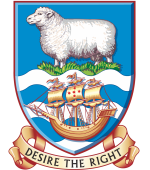Environment
Introduction
The environment, and its protection from any possible adverse effects of commercial activities, is of prime concern to the Falkland Islands Government.
Several pieces of legislation have been enacted to protect the environment: these are modelled on UK laws. The Offshore Minerals Ordinance 1994 (as amended) and the Conservation of Wildlife and Nature Ordinance 1999 provide the basis for the environmental protection legislation. Further provisions ensuring the protection of the environment are contained in individual production licences.
Climate
The Islands are at about 52°S, and are therefore at a similar latitude south as London and Calgary are north. The climate of the Falkland Islands is similar to that of northeast Scotland, and exploration activity can take place for most if not all of the year.
Climatic Impacts on Exploration Activity
Seismic surveys conducted around the Islands since 1992 have tended to be acquired during the Austral summer months of December to April.
However, examination of the weather and seismic acquisition statistics demonstrates that exploration is possible for most of the year. The annual weather downtime for seismic activities is just 19%.
Month |
Total of seismic shot (2D km) |
Average daily production (2D km) |
Weather downtime (as % of time in production(1)) |
Seismic acquisition |
January |
5483.275 |
53.12 |
15.06 |
Good |
February |
2766.1 |
48.53 |
1.4 |
Good |
March |
3603.925 |
54.04 |
34.4 |
OK |
April |
2823.55 |
25.24 |
28.08 |
OK |
May |
1016.85 |
35.34 |
4.7 |
OK |
June |
585.1 |
21.74 |
64.4 |
Poor |
July |
816.35 |
26.33 |
63.4 |
Poor |
August |
366.164 |
10.93 |
90.0 |
Poor |
September |
1945.607 |
64.85 |
46.1 |
Poor |
October |
428.09 |
107.02 |
0(2) |
Good |
November |
718.4 |
50.56 |
0 |
Good |
December |
4990.15 |
75.61 |
19.7 |
Good |
1 - discount downtime due to mechanical failures 2 - small quantity data collected
Note:these statistics include data up to 2001 only.
Environmental Concerns
The Falkland Islands contain some of the most beautiful, important and accessible seabird and marine mammal populations in the world, along with supporting a wide range of other flora and fauna. The biodiversity in these remote islands has allowed the economy to flourish through sustainable tourism, fishing and agriculture. These industries are the cornerstone of the Islands, and the Falkland Islands Government is committed to protecting and conserving the environment for future generations. All marine mammals are protected under the Marine Mammals Protection Ordinance 1992.
Some parts of the coastline and many of the smaller islands are designated as protected areas. There are plans in progress that may lead to marine designations for a wider range of habitats and species. Designated areas and environmental concerns must be fully considered within each EIA to ensure that all risks and possible impacts are mitigated against.
Highlights
- There are 64 breeding species of birds, over half of which are dependent on the sea for food.
- The Islands boast the world's largest breeding population of black-browed albatross.
- There are five breeding species of penguin on the Falkland Islands — Rockhopper, Magellanic, Gentoo, King and Macaroni.
- Three species of seal (elephant seal, sea lion and fur seal) breed on the Islands, and the less common leopard seal is seen occasionally.
- Porpoises and dolphins are common, as are several species of whales
Marine hazards
The Falklands have numerous rocky islets and shoals in inshore waters, with known shallows recorded on Admiralty charts. Kelp grows in water depths up to 50m and can be a hazard to seismic operations and vessels.
Sea Bed Conditions
Little is known about the nature of sea-bed sediments due to the lack of a systematic sampling program. The sea bed appears to be hard and is a strong seismic reflector in some places. There is a possibility of gas hydrates in deeper waters above the South Falkland Basin. A high-resolution seismic program was conducted in the North Falkland Basin before drilling six exploration wells in 1998, indicating potential shallow gas hazards. However, no such hazards were encountered during drilling. Military manoeuvres are possible in the offshore area but can be structured to avoid interference with exploration work.
Restrictions
Shipwrecks and War Graves
Numerous wrecks dating back to the last century lie in inshore waters of the Falkland Islands, including six from World War 1 and some from the 1982 conflict between Britain and Argentina. The 1914 wrecks are in waters deeper than 500 m, and some of the newer ones are designated war graves and must not be disturbed.
Fishing
The sale of fishing licences provides the largest single source of income for the Falkland Islands, and fishing fleets tend to occupy a large swathe of Falklands offshore waters for significant time periods. Therefore, certain restrictions are placed on geophysical survey activities around the Islands. In summary, these restrictions are:
- No seismic surveying is generally permitted within 12 miles of coasts. If there is an overwhelming requirement to conduct seismic within the 12 mile zone, requests will be considered on a case by case basis
- No seismic surveying is permitted in the area north of 52°S and west of 58°W in water depths of less than 200 m during February to June, because fishing for Illex squid takes place in this area at this time. This restriction will not apply during the seven month period from July to January.
- Loligo squid move offshore in January and remain in offshore feeding grounds until October. In view of this, seismic surveys in Quadrants 59, 60, 61, 51 and 40 should ideally take place between mid October and mid January. Applications to conduct seismic surveys in these quadrants outside this period will be considered on a case by case basis, but approval is only likely to be given in exceptional circumstances.
